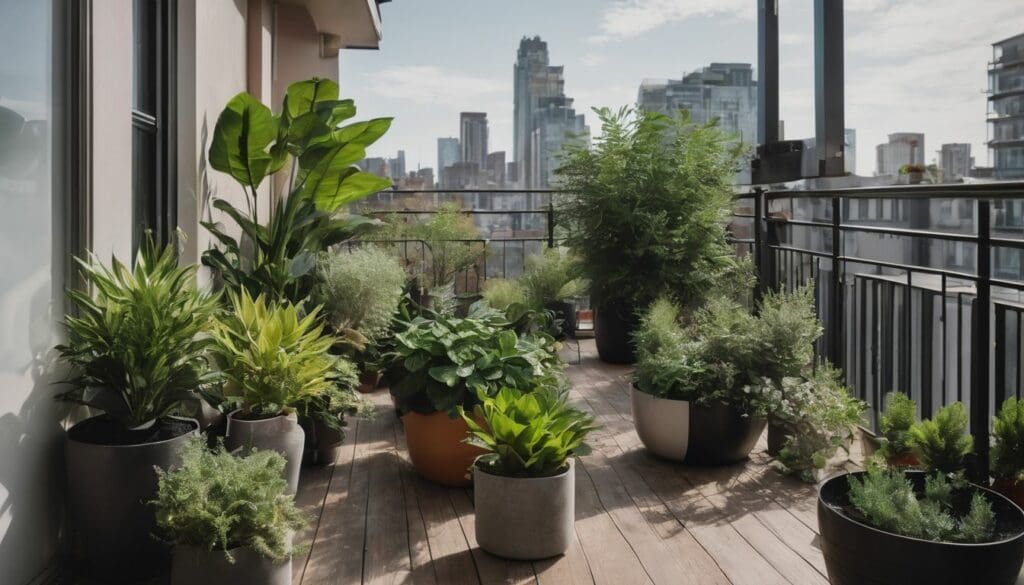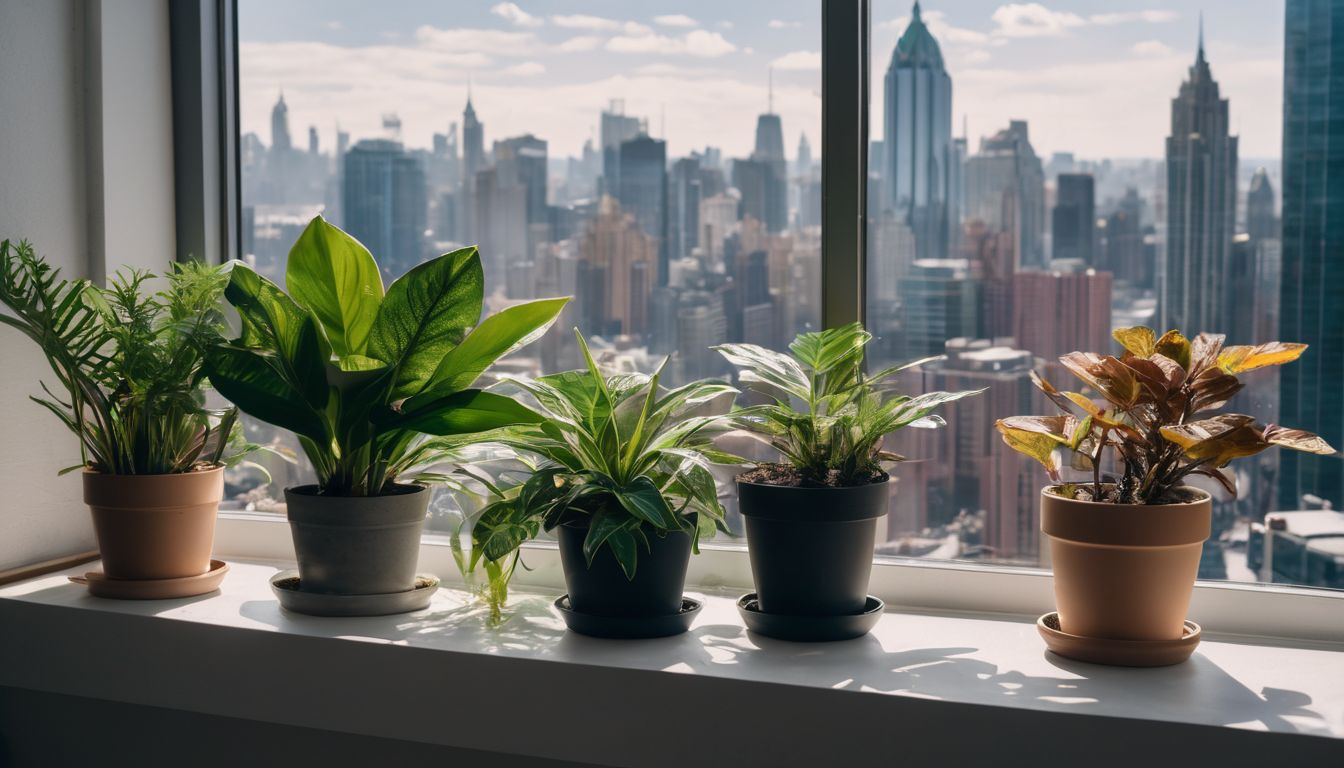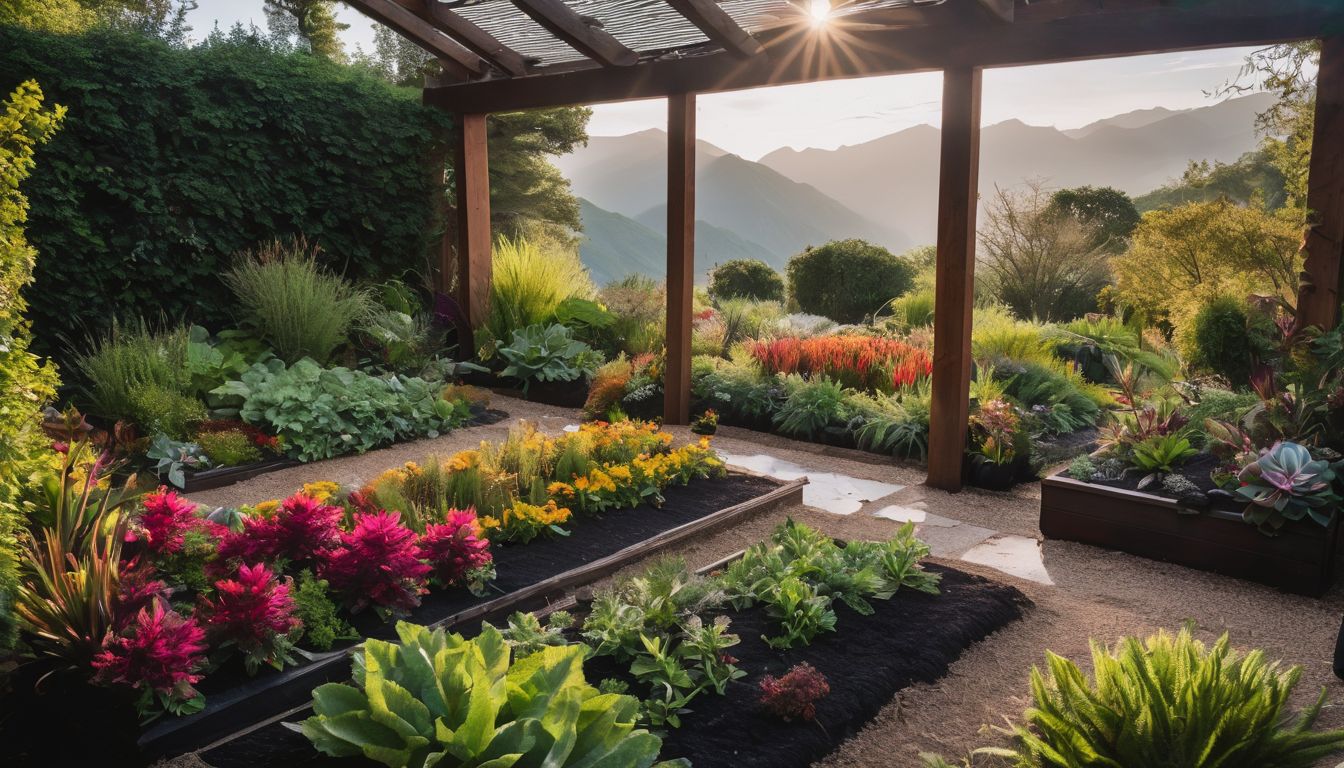Cramped city life often leaves little room for the joys of gardening. Yet, container gardening opens up a world where even a small balcony can be transformed into an oasis of greenery.
This guide unveils how pots and planters can bring the vibrancy of nature right to your urban doorstep, regardless of space constraints. Get ready to grow!
Key Takeaways
- Urban residents with limited space can grow a variety of plants using container gardening techniques that maximise vertical spaces and adapt to changing sunlight conditions.
- With the right selection of containers, soil mix, and plant choices such as vegetables, fruits, herbs, and flowers – even balconies or window sills can become lush gardens contributing to healthier lifestyles.
- Container gardening enables flexibility by allowing gardeners to move plants for optimal growth conditions; plus by growing native species or food crops at home reduces carbon footprints considerably.
- Preparing your garden for success involves choosing well – draining soil mixes, regular watering, appropriate fertilisation, pest control strategies and preparing plants for different seasons including winter protection measures.
- Container gardens demand consistent care through maintenance tips like deadheading flowers or harvesting produce when ready which ensures vitality and yield in confined urban settings.
What is Container Gardening?
Container gardening is the practice of growing plants in containers instead of traditional garden beds. It’s a space-saving solution for urban dwellers, offering an adaptable and portable way to grow vegetables, fruits, herbs, and flowers even with limited outdoor space.
Benefits for urban dwellers
Container gardening revolutionises how city dwellers interact with nature without the need for expansive landscapes. For those living in apartments or homes with limited outdoor space, this approach to cultivating plants can transform balconies, patios, and window sills into lush green retreats.
It offers a practical way to grow your own veggies, fruits, herbs, and flowers right at your doorstep.
Urban agriculture through container gardening not only beautifies small spaces but also fosters a connection to the environment and local ecosystems. Residents gain the satisfaction of nurturing plant life and reaping fresh produce that contributes to healthier lifestyles.
Moreover, it reduces one’s carbon footprint by minimising the transportation of food from farm to table.
Space-saving solution
With limited outdoor space or a small balcony at your disposal, container gardening offers apartment dwellers and urban residents the perfect space-saving solution for cultivating a thriving garden.
By maximising vertical space, utilising window boxes, raised beds, and strategically selecting compact plants that can thrive in pots and containers, you can create an abundant edible garden without needing vast amounts of land.
This mobile gardening approach allows you to adapt your urban garden according to available sunlight and shifting weather patterns while still enjoying the beauty of flowers interspersed amidst your vegetables and fruits.
By choosing smaller varieties of plants like dwarf tomatoes, patio cucumbers, strawberries, and compact herbs such as basil or mint along with trellising vine crops like peas or beans on supports within your containers, you can make efficient use of the available space.
Portable and adaptable
For urban dwellers, container gardening offers a portable and adaptable solution to limited outdoor space. It allows you to move your plants around as needed and adjust their placement based on sunlight and temperature requirements.
Whether you have a small balcony, patio, or even just a windowsill, container gardening provides the flexibility to grow vegetables, fruits, herbs, and flowers in compact spaces without sacrificing variety or yield.
When choosing containers for your urban garden, opt for lightweight options that are easy to relocate. Utilise hanging baskets or wall-mounted planters to maximise vertical space and create stunning living walls of foliage.
This adaptability ensures that regardless of your living situation or outdoor area limitations, you can still enjoy the benefits of growing your own produce and creating an inviting green oasis within your urban environment.
Choosing Plants for Container Gardening
When it comes to choosing plants for your container garden, you have a variety of options including vegetables, fruits, herbs, and flowers. You can also maximise vertical space by considering climbing or trailing plants for your containers.
Consider the specific needs of each plant when selecting them for your urban garden.
Vegetables, fruits, herbs, and flowers
Container gardening is a versatile way to grow a variety of plants in limited urban spaces.You can plant vegetables, fruits, herbs, and flowers in containers. Here’s how:
- Choose vegetables like tomatoes, peppers, and lettuce that thrive in containers. Grow fruits such as strawberries or dwarf fruit trees in pots.
- Plant herbs like basil, parsley, and mint which are perfect for small spaces.
- Select flowers such as petunias, marigolds, or pansies to add color to your urban garden.
Maximize vertical space
When it comes to container gardening in limited outdoor spaces, maximising vertical space is essential for growing a variety of vegetables, fruits, herbs, and flowers. By using hanging baskets, trellises, and wall-mounted planters, you can make the most of your available space.
These vertical gardening techniques not only allow you to grow more plants but also create an attractive green wall or curtain that adds beauty to your urban environment. Additionally, utilising shelving units and tiered plant stands will further optimise your space while providing easy access for watering and maintenance.
To maximise useable area in small gardens or balconies without overcrowding, consider combining trailing plants with upright varieties. Vining plants such as tomatoes and cucumbers can be trained to grow upwards along trellises or stakes rather than sprawling horizontally across the ground.
Consideration for plant selection
When selecting plants for container gardening, consider the available sunlight and climate conditions to match the needs of each plant. Pay attention to the size of mature plants, ensuring they will not outgrow their containers.
Choose a variety of plants that complement each other in terms of growth habits, watering requirements, and nutrient needs. Select plants that are suitable for small spaces and can thrive in containers over an extended period.
To maximise success with limited space gardening, carefully select plants that serve both aesthetic and practical purposes while aligning with your environmental values. Consider choosing native or drought-tolerant species to support local ecosystems and reduce water consumption.
Selecting the Perfect Containers
Choose containers that suit the needs of your plants, whether it’s a window box for flowers, a raised bed for vegetables, or pots for herbs – find out more about selecting the perfect containers to start your urban garden.
Types of containers
Container gardening offers a variety of options when it comes to the type of containers you can use. Here are several diverse choices for your container gardening needs:
- Terracotta pots: These traditional clay pots add a touch of rustic charm to your garden and provide good air circulation for plant roots.
- Plastic containers: Lightweight and affordable, plastic pots come in various sizes, shapes, and colours, making them an adaptable choice.
- Hanging baskets: Perfect for vertical gardening and ideal for trailing plants such as strawberries or ornamental vines.
- Wooden boxes: A sustainable option that can be custom-built to fit your space and aesthetic preferences.
- Grow bags: Made from breathable fabric, these are excellent for root aeration and drainage while being easily portable.
- Window boxes: Ideal for small spaces like balconies or windowsills, providing a convenient option for growing herbs or flowers.
- Recycled containers: Get creative and repurpose items like buckets, crates, or even old furniture to create unique and eco-friendly planters.
- Self-watering containers: These innovative pots come with water reservoirs that ensure consistent moisture levels for your plants, reducing the frequency of watering.
- Fabric pots: Durable and flexible, these breathable containers are great for promoting healthy root growth due to their ability to air-prune roots.
- Hanging pockets: Perfect for vertical gardens on walls or fences, providing an efficient use of space while adding visual interest to your garden area.
Best containers for different plant types
For vegetables, consider using deep pots or grow bags to allow for root growth. Tomatoes do well in 5-gallon containers while carrots thrive in long, shallow troughs. Lettuce and salad greens can be planted in wide, shallow planters.
Herbs such as basil and mint flourish in smaller containers on sunny windowsills or balconies.
When it comes to fruits, dwarf varieties of fruit trees like apples, cherries, and peaches are perfect for large containers. Strawberries thrive in hanging baskets or strawberry jars with pockets around the sides for their runners to grow into.
Blueberries prefer acidic soil mixtures but can also be grown successfully in large pots filled with ericaceous compost.
For flowers, choose lightweight materials such as plastic or resin when planting bright annuals like petunias and marigolds that need frequent watering. Additionally, ceramic or terracotta pots work well for perennials like lavender and daisies due to their ability to retain moisture during hot weather.
Considerations for drainage and size
When choosing containers for your urban garden, consider the drainage and size. The right drainage is vital to prevent waterlogging, which can harm your plants. Ensure that the containers have drainage holes or choose self-watering pots.
Additionally, select appropriately sized containers for each plant type to allow sufficient root growth and ensure they fit in your available space.
For fruits in pots, a larger container with good drainage will support healthy growth. Flowers in small spaces require well-drained soil and smaller pots suitable for their size. Herbs in containers thrives best in medium-sized pots with adequate drainage to maintain their moisture levels.
How to Start a Container Garden
Preparing the soil is crucial for a successful container garden. Choose the right soil mix, and follow planting and maintenance tips to ensure your plants thrive in their new environment.
Preparing soil
To prepare the soil for your container garden, start by choosing a high-quality potting mix that is well-draining and nutrient-rich. Avoid using regular garden soil as it may become too compacted in containers.
Consider adding organic matter such as compost or worm castings to improve the soil structure and provide essential nutrients for your plants. Make sure to select a container with good drainage holes to prevent waterlogging, and consider adding a layer of gravel at the bottom before filling it with potting mix to further aid drainage.
Once you have filled your containers with the appropriate soil mix, gently firm down the surface without compacting it too much. This will create a stable environment for your plants’ roots while still allowing air and moisture to penetrate.
Choosing the right soil mix
When preparing your soil for container gardening, it’s important to choose the right soil mix. A good mix provides essential nutrients, proper water drainage, and aeration for healthy plant growth.
Look for a high-quality potting mix containing organic matter and perlite for moisture retention and root development. Consider adding compost or slow-release fertiliser to ensure a steady supply of nutrients throughout the growing season.
Also, consider specific mixes tailored to the types of plants you’ll be growing – such as acidic mixes for blueberries or cacti/succulent blends for desert plants.
Planting and maintenance tips
After choosing the right soil mix, it’s important to consider planting and maintenance tips to ensure the success of your container garden. Here are some essential tips to keep in mind:
- Regular watering: Ensure plants are adequately watered. Check moisture levels daily, especially during hot weather.
- Fertilise appropriately: Use a balanced fertiliser to supplement nutrients in the soil. Follow packaging instructions for frequency.
- Pruning and deadheading: Regularly remove dead or decaying leaves and flowers to promote healthy growth.
- Pest control: Keep an eye out for pests and take necessary steps for organic pest control using natural remedies like neem oil or insecticidal soap.
- Disease prevention: Monitor your plants for signs of disease and promptly treat any issues with appropriate solutions.
- Support tall plants: Provide stakes or cages to support taller plants as they grow to prevent bending or breaking.
- Harvest regularly: Enjoy the fruits of your labour by harvesting ripe produce regularly, promoting continuous growth.
Container Garden Tips and Tricks
Maximise your success with container gardening by learning how to keep wildlife out, watering while on holiday, preparing for winter, and other useful tips and tricks to make the most of your urban garden.
Keeping wildlife out
To keep wildlife out of your container garden, use physical barriers such as wire mesh or netting. This will deter pests like rabbits and squirrels from accessing your plants while allowing air and sunlight to penetrate.
Additionally, planting strong-smelling herbs like mint, lavender, or rosemary can help repel unwanted visitors without harming them. Regularly inspecting your plants for signs of pest damage is crucial in maintaining a healthy and thriving container garden.
Remember to avoid using harmful pesticides that can harm the environment and non-targeted species while caring for your beloved urban green space.
Watering while on vacation
When going on vacation, make a plan to keep your container garden hydrated. Ask a neighbour to water it or set up an automatic watering system. Place containers in a shaded spot to reduce water evaporation and use self-watering containers for extended trips, ensuring that your plants stay healthy and flourishing while you’re away.
Moving on to the next section about “Preparing for winter,” let’s look at how you can best protect your container garden during the colder months.
Preparing for winter
Prepare your container garden for the winter by moving sensitive plants indoors or providing appropriate protection. Before the first frost, wrap containers with insulating materials or move them to a sheltered area.
Consider using cold frames or cloches to extend the growing season and protect plants from harsh weather conditions.
As temperatures drop, reduce watering frequency but ensure that plants do not dry out completely. Prune back dead growth and remove any fallen leaves to prevent disease and pests from taking hold during the dormant season.
Maximizing success with container gardening.
Preparing for winter is crucial when it comes to container gardening. To maximise success, insulate containers with bubble wrap or hessian sacks. Keep plants well-watered before the cold weather sets in to maintain healthy roots.
Consider moving containers closer to the house or into a greenhouse for added protection from the elements. Additionally, covering plants with fleece can safeguard them while allowing air and moisture through.
To make the most of your container garden, focus on regular maintenance tasks such as pruning and deadheading to encourage continuous growth and blooms. Regularly check soil moisture levels and adjust watering accordingly.
Conclusion
In conclusion, container gardening offers a versatile and space-saving solution for urban dwellers. By choosing the right plants and containers, individuals can enjoy growing their own vegetables, fruits, herbs, and flowers in limited outdoor spaces like balconies or small city gardens.
With proper care and maintenance, container gardening can thrive throughout the year, providing sustainable and rewarding benefits to environmentally conscious individuals supporting conservation efforts.
FAQs
1. What is container gardening for urban dwellers?
Container gardening for urban dwellers is growing veggies and fruits in pots or containers, perfect for city living where outdoor space might be limited.
2. Can I still have a garden if I live in an apartment with no yard?
Yes, apartment gardening using containers allows you to grow plants on balconies or patios, making use of any small space you have available.
3. Is it possible to grow a variety of plants in containers?
Absolutely! You can cultivate various container plants including herbs, vegetables, and flowers even when dealing with limited outdoor space.
4. How do potted plants work differently from garden plots?
Potted plants require special care compared to ground planting; they need the right soil mix and frequent watering since they’re confined to smaller spaces like pots or raised beds.
5. Are there benefits to balcony gardening in dense city areas?
Yes indeed! Balcony gardening provides fresh air and personal greenery whilst also offering a relaxing hobby within your own private small space amidst the hectic city life.





